Analysis of Microservice Architecture for Cloud Computing at VideoDev
VerifiedAdded on 2022/12/21
|12
|3017
|53
Report
AI Summary
This report presents a comprehensive analysis of VideoDev, a video production and development company aiming to transition its infrastructure to cloud computing to enhance flexibility and reduce maintenance costs. The report assesses the company's video application modules, identifying stable modules, those requiring modification, and those susceptible to workload peaks. It explores the shift from a monolithic to a microservice architecture, recommending the reconstruction of key modules like customer and video processing. The report highlights the benefits of microservices in resolving issues such as performance degradation and security concerns during peak times, ultimately improving VideoDev's capabilities by enhancing scalability, efficiency, and maintainability. A microservice architecture diagram is included to illustrate the proposed structure. The report concludes by summarizing the benefits of cloud migration and microservices in the context of VideoDev's business goals.
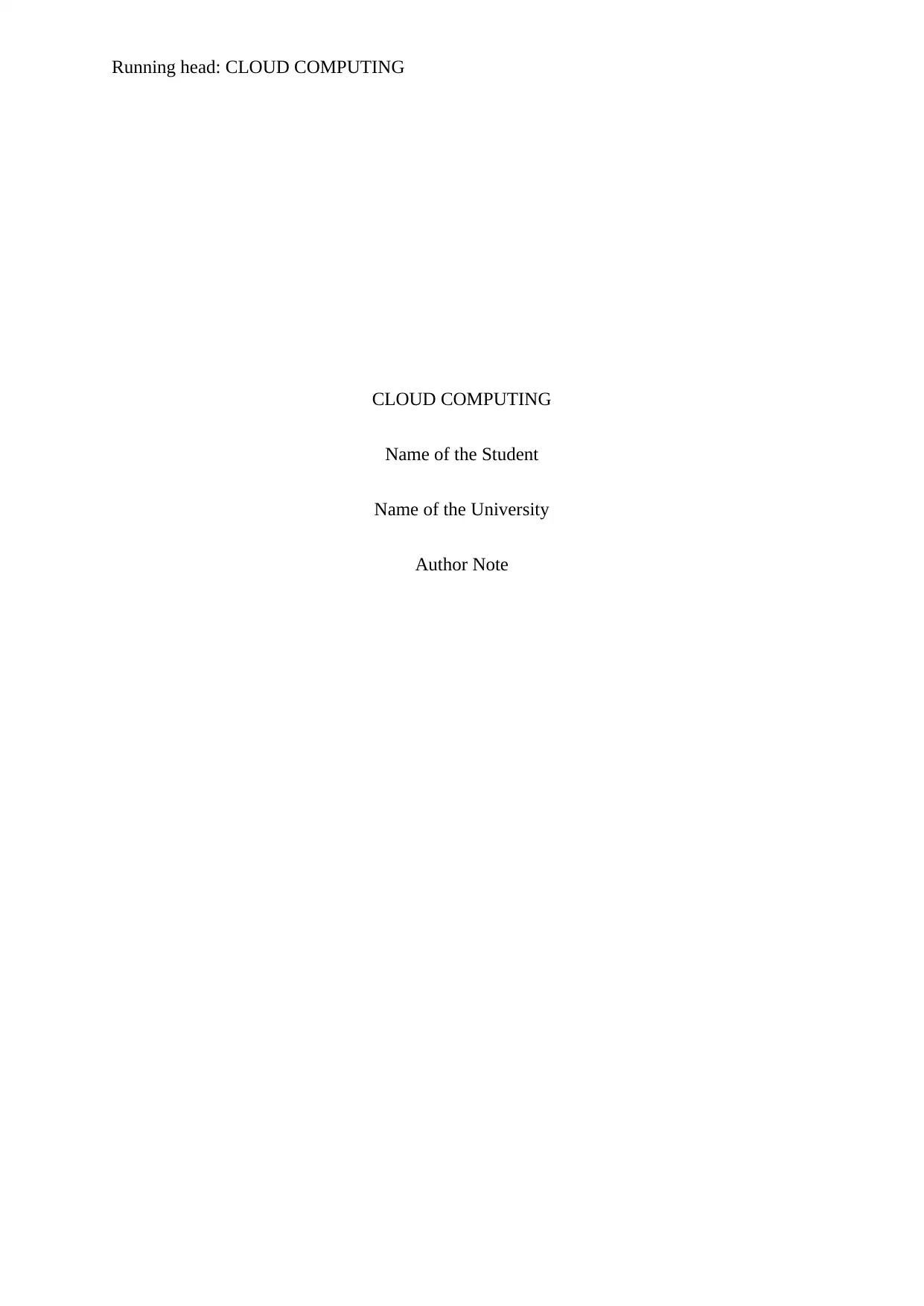
Running head: CLOUD COMPUTING
CLOUD COMPUTING
Name of the Student
Name of the University
Author Note
CLOUD COMPUTING
Name of the Student
Name of the University
Author Note
Paraphrase This Document
Need a fresh take? Get an instant paraphrase of this document with our AI Paraphraser
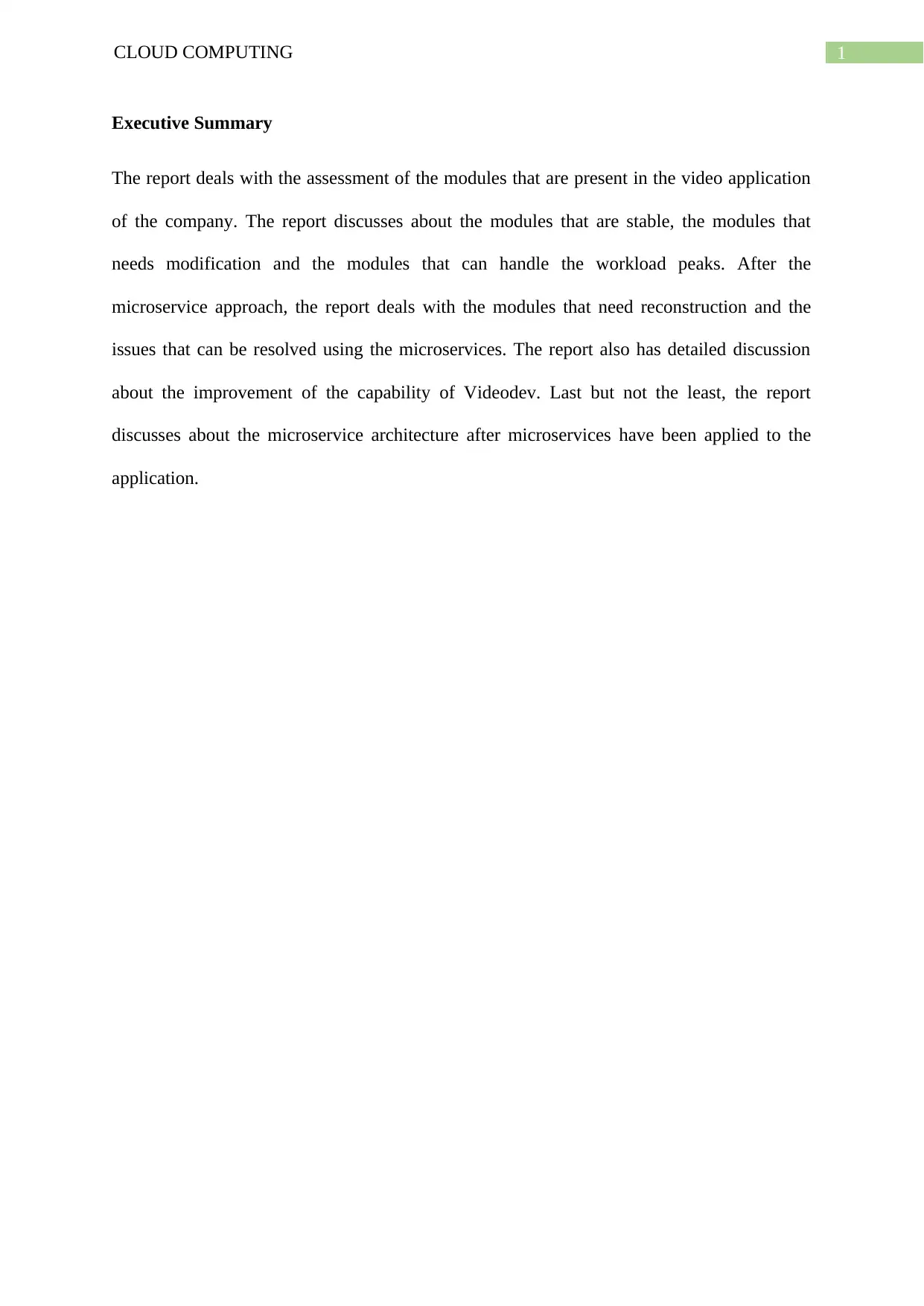
1CLOUD COMPUTING
Executive Summary
The report deals with the assessment of the modules that are present in the video application
of the company. The report discusses about the modules that are stable, the modules that
needs modification and the modules that can handle the workload peaks. After the
microservice approach, the report deals with the modules that need reconstruction and the
issues that can be resolved using the microservices. The report also has detailed discussion
about the improvement of the capability of Videodev. Last but not the least, the report
discusses about the microservice architecture after microservices have been applied to the
application.
Executive Summary
The report deals with the assessment of the modules that are present in the video application
of the company. The report discusses about the modules that are stable, the modules that
needs modification and the modules that can handle the workload peaks. After the
microservice approach, the report deals with the modules that need reconstruction and the
issues that can be resolved using the microservices. The report also has detailed discussion
about the improvement of the capability of Videodev. Last but not the least, the report
discusses about the microservice architecture after microservices have been applied to the
application.
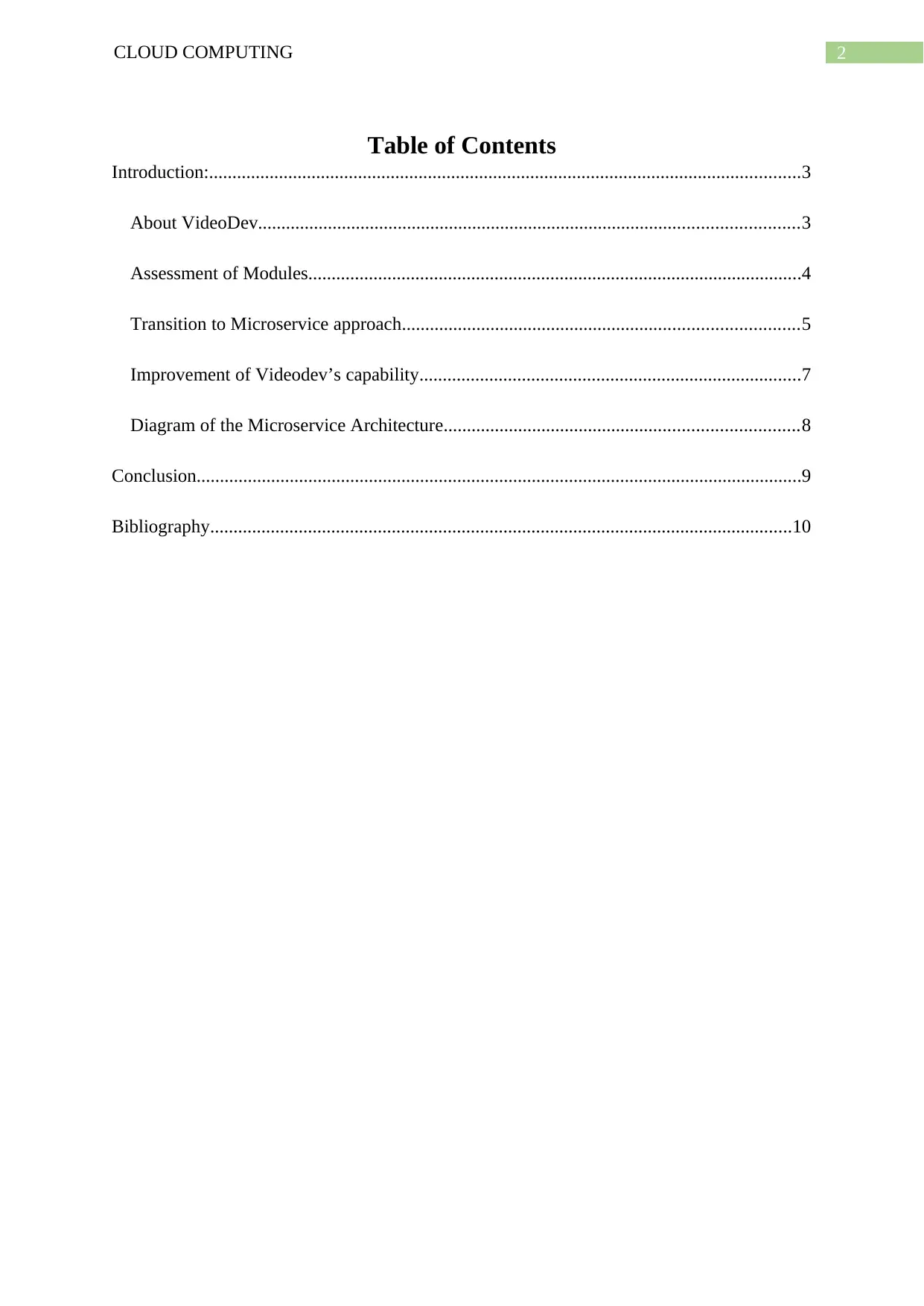
2CLOUD COMPUTING
Table of Contents
Introduction:...............................................................................................................................3
About VideoDev....................................................................................................................3
Assessment of Modules..........................................................................................................4
Transition to Microservice approach.....................................................................................5
Improvement of Videodev’s capability..................................................................................7
Diagram of the Microservice Architecture............................................................................8
Conclusion..................................................................................................................................9
Bibliography.............................................................................................................................10
Table of Contents
Introduction:...............................................................................................................................3
About VideoDev....................................................................................................................3
Assessment of Modules..........................................................................................................4
Transition to Microservice approach.....................................................................................5
Improvement of Videodev’s capability..................................................................................7
Diagram of the Microservice Architecture............................................................................8
Conclusion..................................................................................................................................9
Bibliography.............................................................................................................................10
⊘ This is a preview!⊘
Do you want full access?
Subscribe today to unlock all pages.

Trusted by 1+ million students worldwide
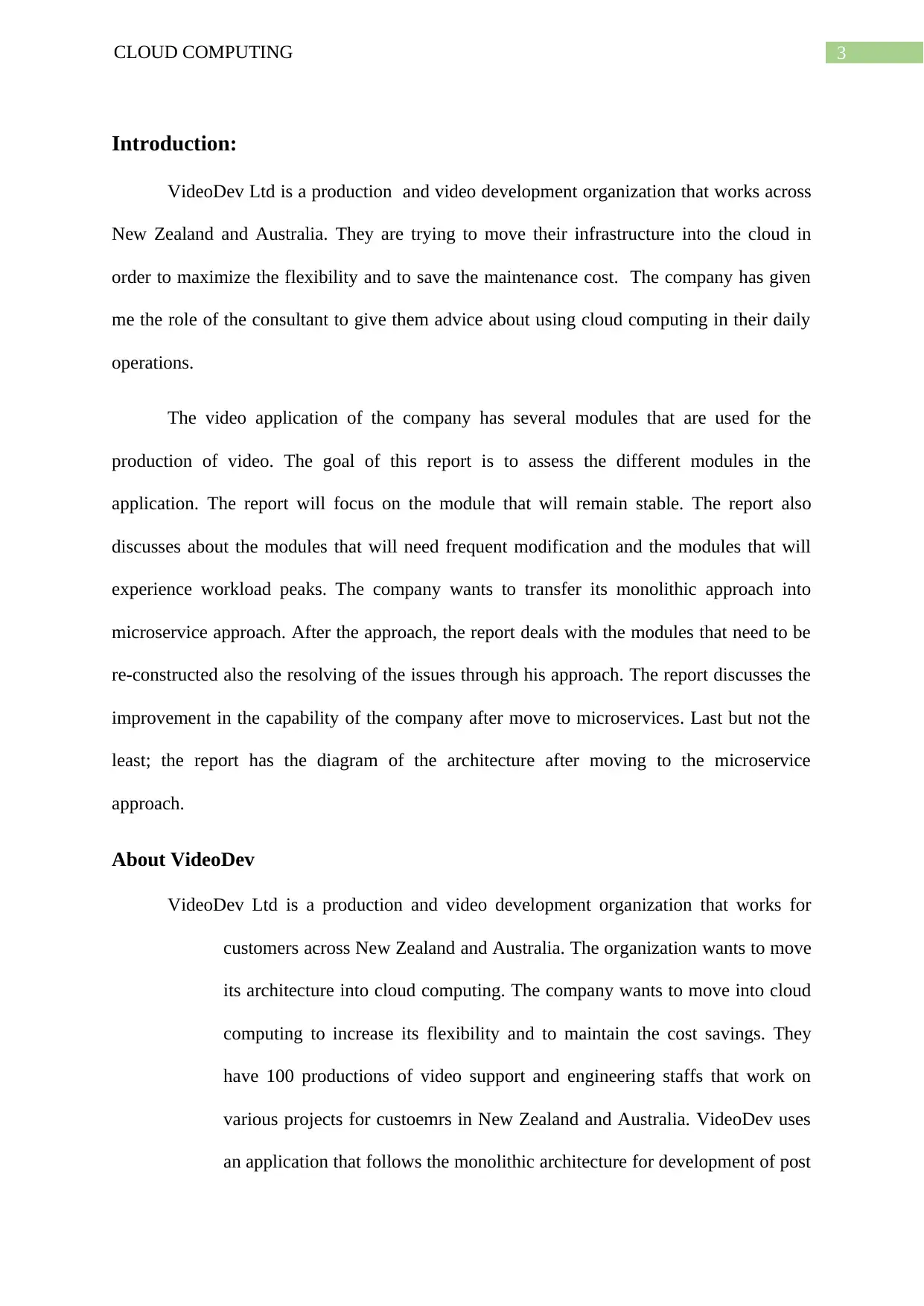
3CLOUD COMPUTING
Introduction:
VideoDev Ltd is a production and video development organization that works across
New Zealand and Australia. They are trying to move their infrastructure into the cloud in
order to maximize the flexibility and to save the maintenance cost. The company has given
me the role of the consultant to give them advice about using cloud computing in their daily
operations.
The video application of the company has several modules that are used for the
production of video. The goal of this report is to assess the different modules in the
application. The report will focus on the module that will remain stable. The report also
discusses about the modules that will need frequent modification and the modules that will
experience workload peaks. The company wants to transfer its monolithic approach into
microservice approach. After the approach, the report deals with the modules that need to be
re-constructed also the resolving of the issues through his approach. The report discusses the
improvement in the capability of the company after move to microservices. Last but not the
least; the report has the diagram of the architecture after moving to the microservice
approach.
About VideoDev
VideoDev Ltd is a production and video development organization that works for
customers across New Zealand and Australia. The organization wants to move
its architecture into cloud computing. The company wants to move into cloud
computing to increase its flexibility and to maintain the cost savings. They
have 100 productions of video support and engineering staffs that work on
various projects for custoemrs in New Zealand and Australia. VideoDev uses
an application that follows the monolithic architecture for development of post
Introduction:
VideoDev Ltd is a production and video development organization that works across
New Zealand and Australia. They are trying to move their infrastructure into the cloud in
order to maximize the flexibility and to save the maintenance cost. The company has given
me the role of the consultant to give them advice about using cloud computing in their daily
operations.
The video application of the company has several modules that are used for the
production of video. The goal of this report is to assess the different modules in the
application. The report will focus on the module that will remain stable. The report also
discusses about the modules that will need frequent modification and the modules that will
experience workload peaks. The company wants to transfer its monolithic approach into
microservice approach. After the approach, the report deals with the modules that need to be
re-constructed also the resolving of the issues through his approach. The report discusses the
improvement in the capability of the company after move to microservices. Last but not the
least; the report has the diagram of the architecture after moving to the microservice
approach.
About VideoDev
VideoDev Ltd is a production and video development organization that works for
customers across New Zealand and Australia. The organization wants to move
its architecture into cloud computing. The company wants to move into cloud
computing to increase its flexibility and to maintain the cost savings. They
have 100 productions of video support and engineering staffs that work on
various projects for custoemrs in New Zealand and Australia. VideoDev uses
an application that follows the monolithic architecture for development of post
Paraphrase This Document
Need a fresh take? Get an instant paraphrase of this document with our AI Paraphraser
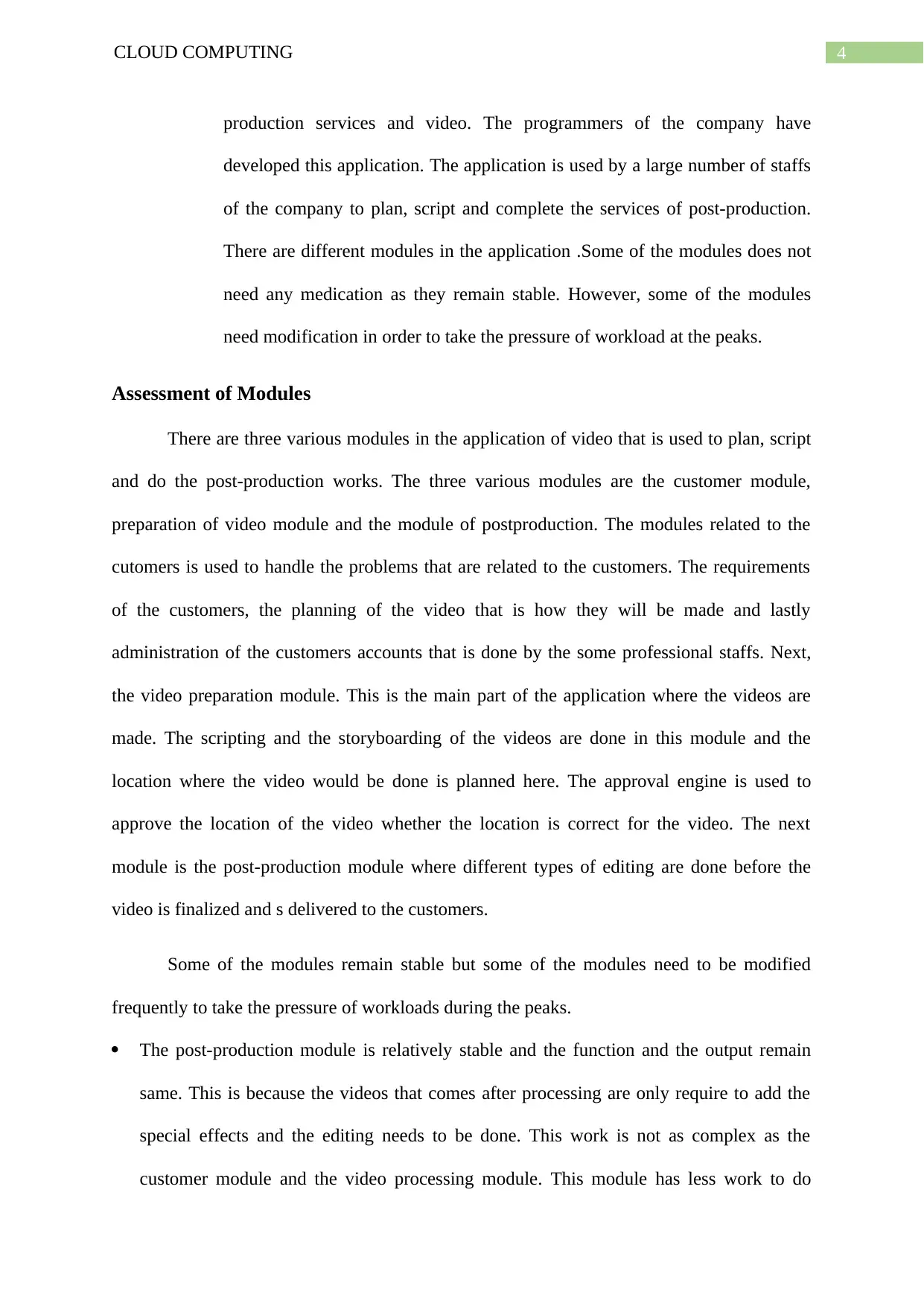
4CLOUD COMPUTING
production services and video. The programmers of the company have
developed this application. The application is used by a large number of staffs
of the company to plan, script and complete the services of post-production.
There are different modules in the application .Some of the modules does not
need any medication as they remain stable. However, some of the modules
need modification in order to take the pressure of workload at the peaks.
Assessment of Modules
There are three various modules in the application of video that is used to plan, script
and do the post-production works. The three various modules are the customer module,
preparation of video module and the module of postproduction. The modules related to the
cutomers is used to handle the problems that are related to the customers. The requirements
of the customers, the planning of the video that is how they will be made and lastly
administration of the customers accounts that is done by the some professional staffs. Next,
the video preparation module. This is the main part of the application where the videos are
made. The scripting and the storyboarding of the videos are done in this module and the
location where the video would be done is planned here. The approval engine is used to
approve the location of the video whether the location is correct for the video. The next
module is the post-production module where different types of editing are done before the
video is finalized and s delivered to the customers.
Some of the modules remain stable but some of the modules need to be modified
frequently to take the pressure of workloads during the peaks.
The post-production module is relatively stable and the function and the output remain
same. This is because the videos that comes after processing are only require to add the
special effects and the editing needs to be done. This work is not as complex as the
customer module and the video processing module. This module has less work to do
production services and video. The programmers of the company have
developed this application. The application is used by a large number of staffs
of the company to plan, script and complete the services of post-production.
There are different modules in the application .Some of the modules does not
need any medication as they remain stable. However, some of the modules
need modification in order to take the pressure of workload at the peaks.
Assessment of Modules
There are three various modules in the application of video that is used to plan, script
and do the post-production works. The three various modules are the customer module,
preparation of video module and the module of postproduction. The modules related to the
cutomers is used to handle the problems that are related to the customers. The requirements
of the customers, the planning of the video that is how they will be made and lastly
administration of the customers accounts that is done by the some professional staffs. Next,
the video preparation module. This is the main part of the application where the videos are
made. The scripting and the storyboarding of the videos are done in this module and the
location where the video would be done is planned here. The approval engine is used to
approve the location of the video whether the location is correct for the video. The next
module is the post-production module where different types of editing are done before the
video is finalized and s delivered to the customers.
Some of the modules remain stable but some of the modules need to be modified
frequently to take the pressure of workloads during the peaks.
The post-production module is relatively stable and the function and the output remain
same. This is because the videos that comes after processing are only require to add the
special effects and the editing needs to be done. This work is not as complex as the
customer module and the video processing module. This module has less work to do
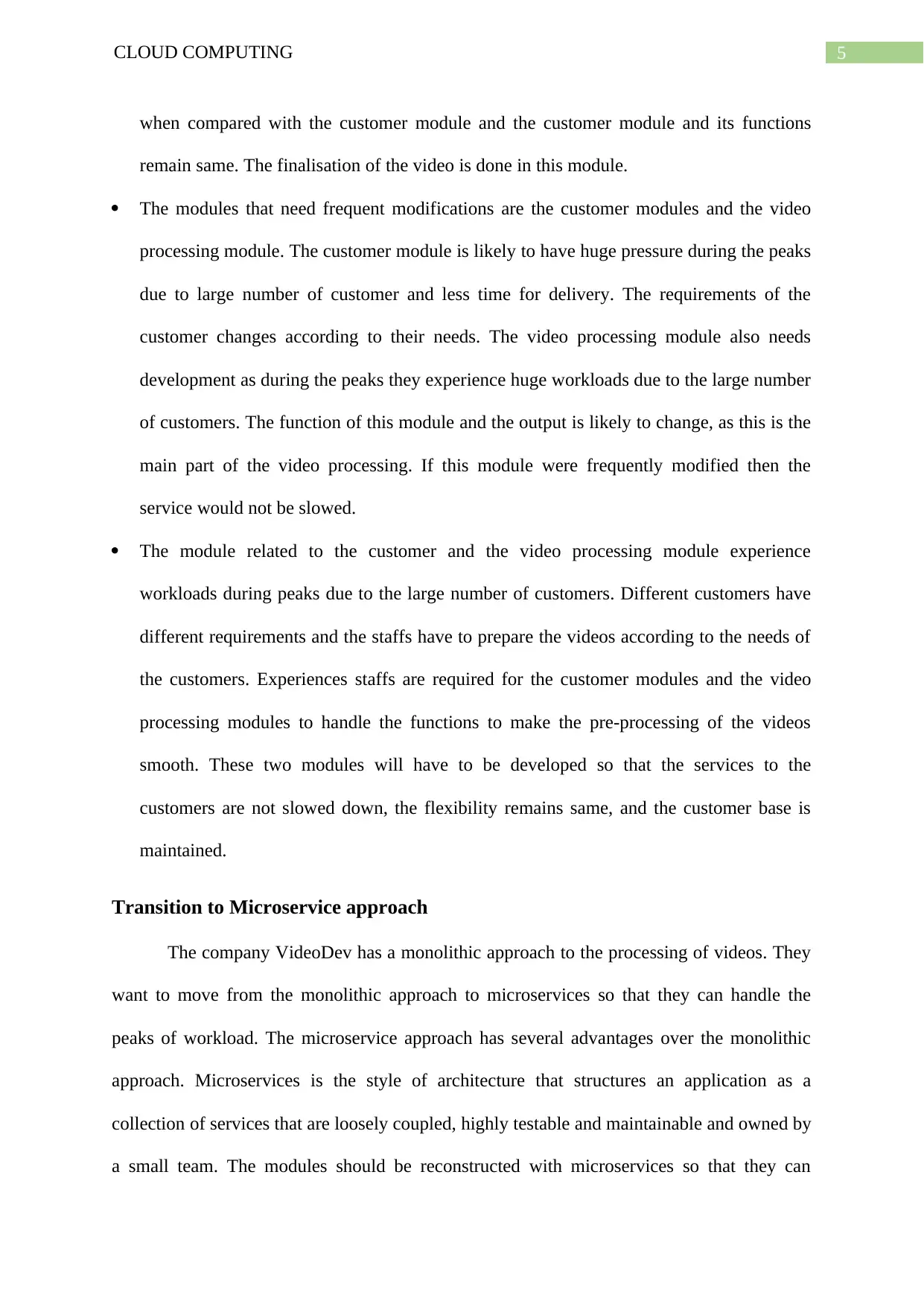
5CLOUD COMPUTING
when compared with the customer module and the customer module and its functions
remain same. The finalisation of the video is done in this module.
The modules that need frequent modifications are the customer modules and the video
processing module. The customer module is likely to have huge pressure during the peaks
due to large number of customer and less time for delivery. The requirements of the
customer changes according to their needs. The video processing module also needs
development as during the peaks they experience huge workloads due to the large number
of customers. The function of this module and the output is likely to change, as this is the
main part of the video processing. If this module were frequently modified then the
service would not be slowed.
The module related to the customer and the video processing module experience
workloads during peaks due to the large number of customers. Different customers have
different requirements and the staffs have to prepare the videos according to the needs of
the customers. Experiences staffs are required for the customer modules and the video
processing modules to handle the functions to make the pre-processing of the videos
smooth. These two modules will have to be developed so that the services to the
customers are not slowed down, the flexibility remains same, and the customer base is
maintained.
Transition to Microservice approach
The company VideoDev has a monolithic approach to the processing of videos. They
want to move from the monolithic approach to microservices so that they can handle the
peaks of workload. The microservice approach has several advantages over the monolithic
approach. Microservices is the style of architecture that structures an application as a
collection of services that are loosely coupled, highly testable and maintainable and owned by
a small team. The modules should be reconstructed with microservices so that they can
when compared with the customer module and the customer module and its functions
remain same. The finalisation of the video is done in this module.
The modules that need frequent modifications are the customer modules and the video
processing module. The customer module is likely to have huge pressure during the peaks
due to large number of customer and less time for delivery. The requirements of the
customer changes according to their needs. The video processing module also needs
development as during the peaks they experience huge workloads due to the large number
of customers. The function of this module and the output is likely to change, as this is the
main part of the video processing. If this module were frequently modified then the
service would not be slowed.
The module related to the customer and the video processing module experience
workloads during peaks due to the large number of customers. Different customers have
different requirements and the staffs have to prepare the videos according to the needs of
the customers. Experiences staffs are required for the customer modules and the video
processing modules to handle the functions to make the pre-processing of the videos
smooth. These two modules will have to be developed so that the services to the
customers are not slowed down, the flexibility remains same, and the customer base is
maintained.
Transition to Microservice approach
The company VideoDev has a monolithic approach to the processing of videos. They
want to move from the monolithic approach to microservices so that they can handle the
peaks of workload. The microservice approach has several advantages over the monolithic
approach. Microservices is the style of architecture that structures an application as a
collection of services that are loosely coupled, highly testable and maintainable and owned by
a small team. The modules should be reconstructed with microservices so that they can
⊘ This is a preview!⊘
Do you want full access?
Subscribe today to unlock all pages.

Trusted by 1+ million students worldwide
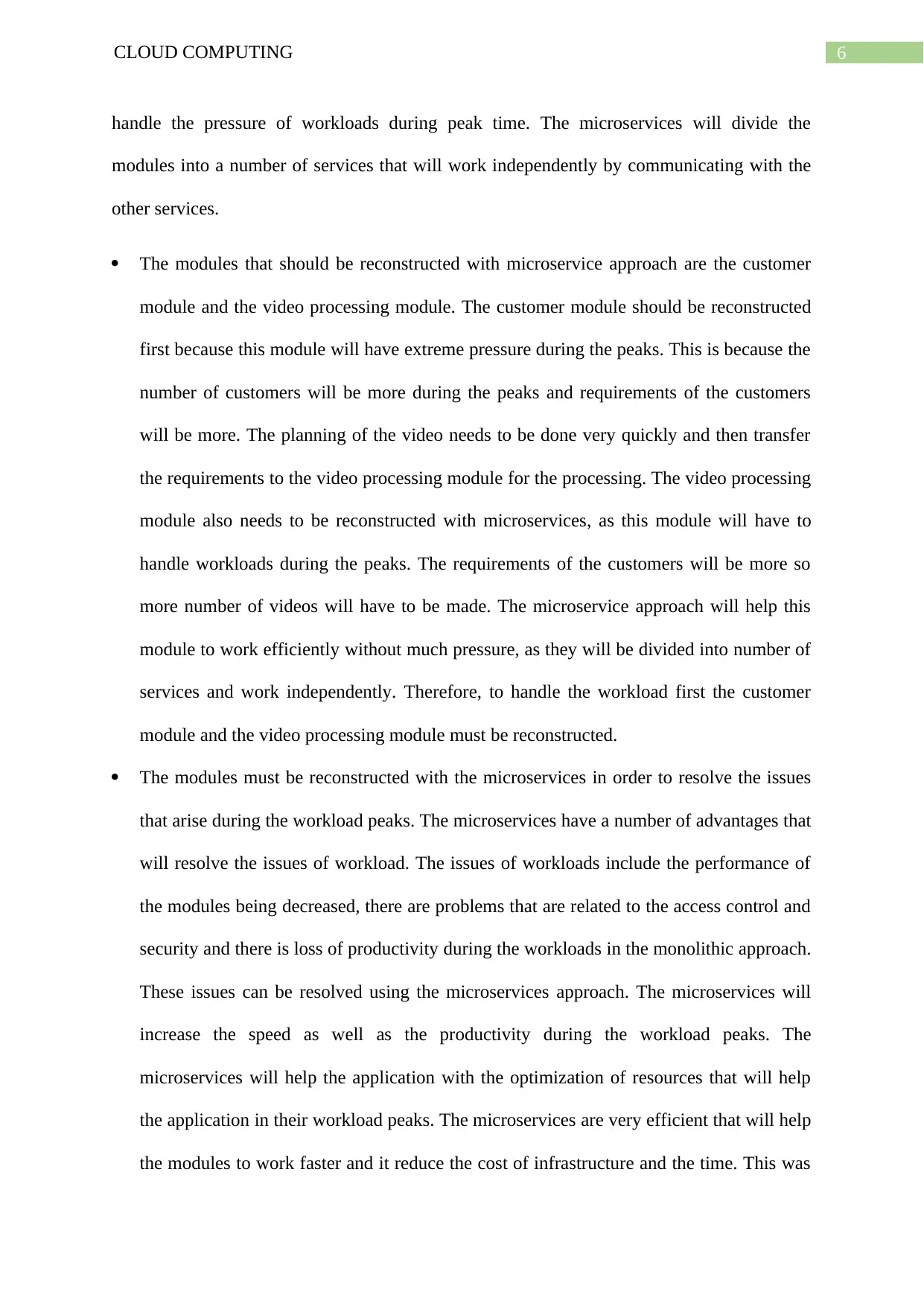
6CLOUD COMPUTING
handle the pressure of workloads during peak time. The microservices will divide the
modules into a number of services that will work independently by communicating with the
other services.
The modules that should be reconstructed with microservice approach are the customer
module and the video processing module. The customer module should be reconstructed
first because this module will have extreme pressure during the peaks. This is because the
number of customers will be more during the peaks and requirements of the customers
will be more. The planning of the video needs to be done very quickly and then transfer
the requirements to the video processing module for the processing. The video processing
module also needs to be reconstructed with microservices, as this module will have to
handle workloads during the peaks. The requirements of the customers will be more so
more number of videos will have to be made. The microservice approach will help this
module to work efficiently without much pressure, as they will be divided into number of
services and work independently. Therefore, to handle the workload first the customer
module and the video processing module must be reconstructed.
The modules must be reconstructed with the microservices in order to resolve the issues
that arise during the workload peaks. The microservices have a number of advantages that
will resolve the issues of workload. The issues of workloads include the performance of
the modules being decreased, there are problems that are related to the access control and
security and there is loss of productivity during the workloads in the monolithic approach.
These issues can be resolved using the microservices approach. The microservices will
increase the speed as well as the productivity during the workload peaks. The
microservices will help the application with the optimization of resources that will help
the application in their workload peaks. The microservices are very efficient that will help
the modules to work faster and it reduce the cost of infrastructure and the time. This was
handle the pressure of workloads during peak time. The microservices will divide the
modules into a number of services that will work independently by communicating with the
other services.
The modules that should be reconstructed with microservice approach are the customer
module and the video processing module. The customer module should be reconstructed
first because this module will have extreme pressure during the peaks. This is because the
number of customers will be more during the peaks and requirements of the customers
will be more. The planning of the video needs to be done very quickly and then transfer
the requirements to the video processing module for the processing. The video processing
module also needs to be reconstructed with microservices, as this module will have to
handle workloads during the peaks. The requirements of the customers will be more so
more number of videos will have to be made. The microservice approach will help this
module to work efficiently without much pressure, as they will be divided into number of
services and work independently. Therefore, to handle the workload first the customer
module and the video processing module must be reconstructed.
The modules must be reconstructed with the microservices in order to resolve the issues
that arise during the workload peaks. The microservices have a number of advantages that
will resolve the issues of workload. The issues of workloads include the performance of
the modules being decreased, there are problems that are related to the access control and
security and there is loss of productivity during the workloads in the monolithic approach.
These issues can be resolved using the microservices approach. The microservices will
increase the speed as well as the productivity during the workload peaks. The
microservices will help the application with the optimization of resources that will help
the application in their workload peaks. The microservices are very efficient that will help
the modules to work faster and it reduce the cost of infrastructure and the time. This was
Paraphrase This Document
Need a fresh take? Get an instant paraphrase of this document with our AI Paraphraser
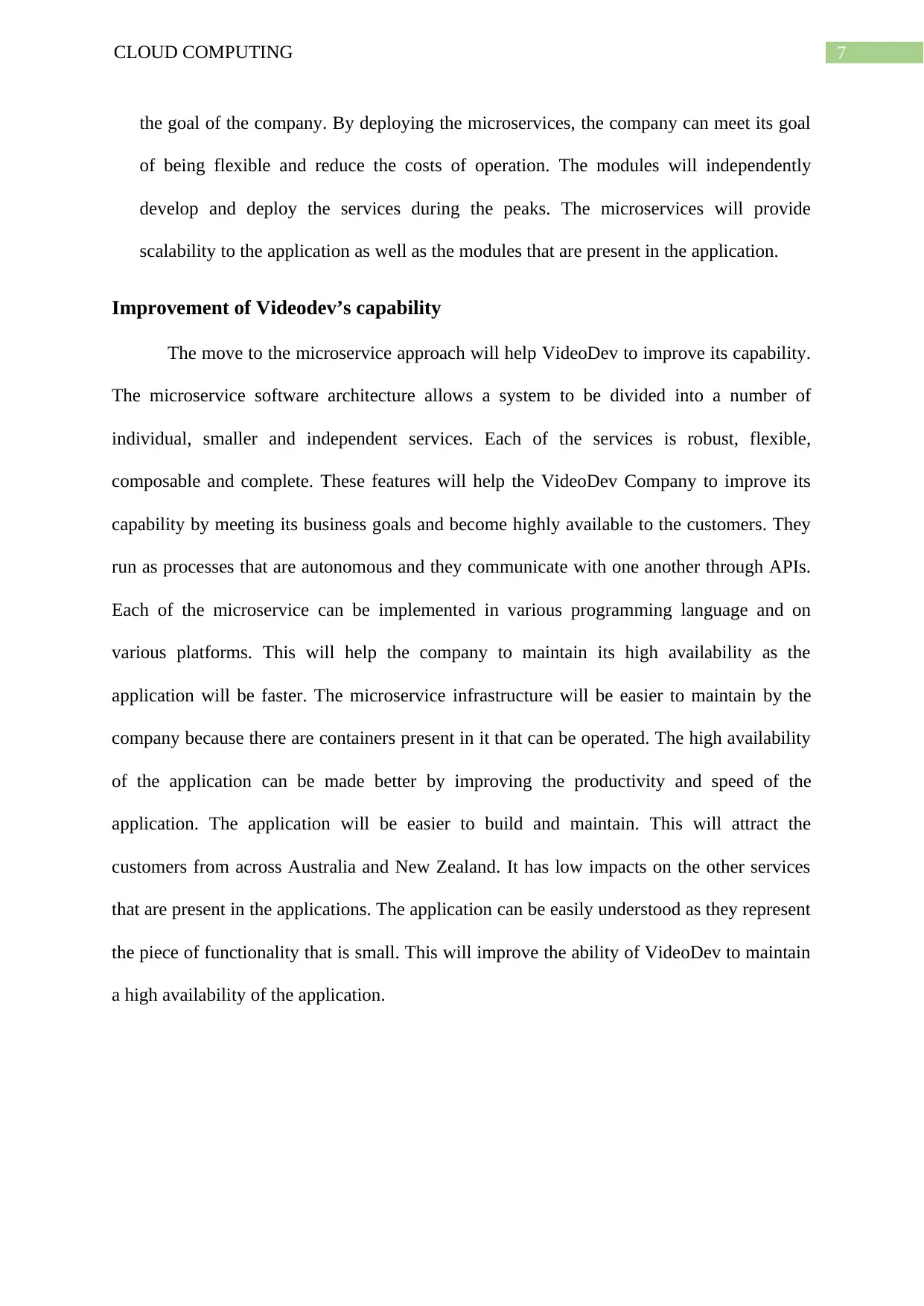
7CLOUD COMPUTING
the goal of the company. By deploying the microservices, the company can meet its goal
of being flexible and reduce the costs of operation. The modules will independently
develop and deploy the services during the peaks. The microservices will provide
scalability to the application as well as the modules that are present in the application.
Improvement of Videodev’s capability
The move to the microservice approach will help VideoDev to improve its capability.
The microservice software architecture allows a system to be divided into a number of
individual, smaller and independent services. Each of the services is robust, flexible,
composable and complete. These features will help the VideoDev Company to improve its
capability by meeting its business goals and become highly available to the customers. They
run as processes that are autonomous and they communicate with one another through APIs.
Each of the microservice can be implemented in various programming language and on
various platforms. This will help the company to maintain its high availability as the
application will be faster. The microservice infrastructure will be easier to maintain by the
company because there are containers present in it that can be operated. The high availability
of the application can be made better by improving the productivity and speed of the
application. The application will be easier to build and maintain. This will attract the
customers from across Australia and New Zealand. It has low impacts on the other services
that are present in the applications. The application can be easily understood as they represent
the piece of functionality that is small. This will improve the ability of VideoDev to maintain
a high availability of the application.
the goal of the company. By deploying the microservices, the company can meet its goal
of being flexible and reduce the costs of operation. The modules will independently
develop and deploy the services during the peaks. The microservices will provide
scalability to the application as well as the modules that are present in the application.
Improvement of Videodev’s capability
The move to the microservice approach will help VideoDev to improve its capability.
The microservice software architecture allows a system to be divided into a number of
individual, smaller and independent services. Each of the services is robust, flexible,
composable and complete. These features will help the VideoDev Company to improve its
capability by meeting its business goals and become highly available to the customers. They
run as processes that are autonomous and they communicate with one another through APIs.
Each of the microservice can be implemented in various programming language and on
various platforms. This will help the company to maintain its high availability as the
application will be faster. The microservice infrastructure will be easier to maintain by the
company because there are containers present in it that can be operated. The high availability
of the application can be made better by improving the productivity and speed of the
application. The application will be easier to build and maintain. This will attract the
customers from across Australia and New Zealand. It has low impacts on the other services
that are present in the applications. The application can be easily understood as they represent
the piece of functionality that is small. This will improve the ability of VideoDev to maintain
a high availability of the application.
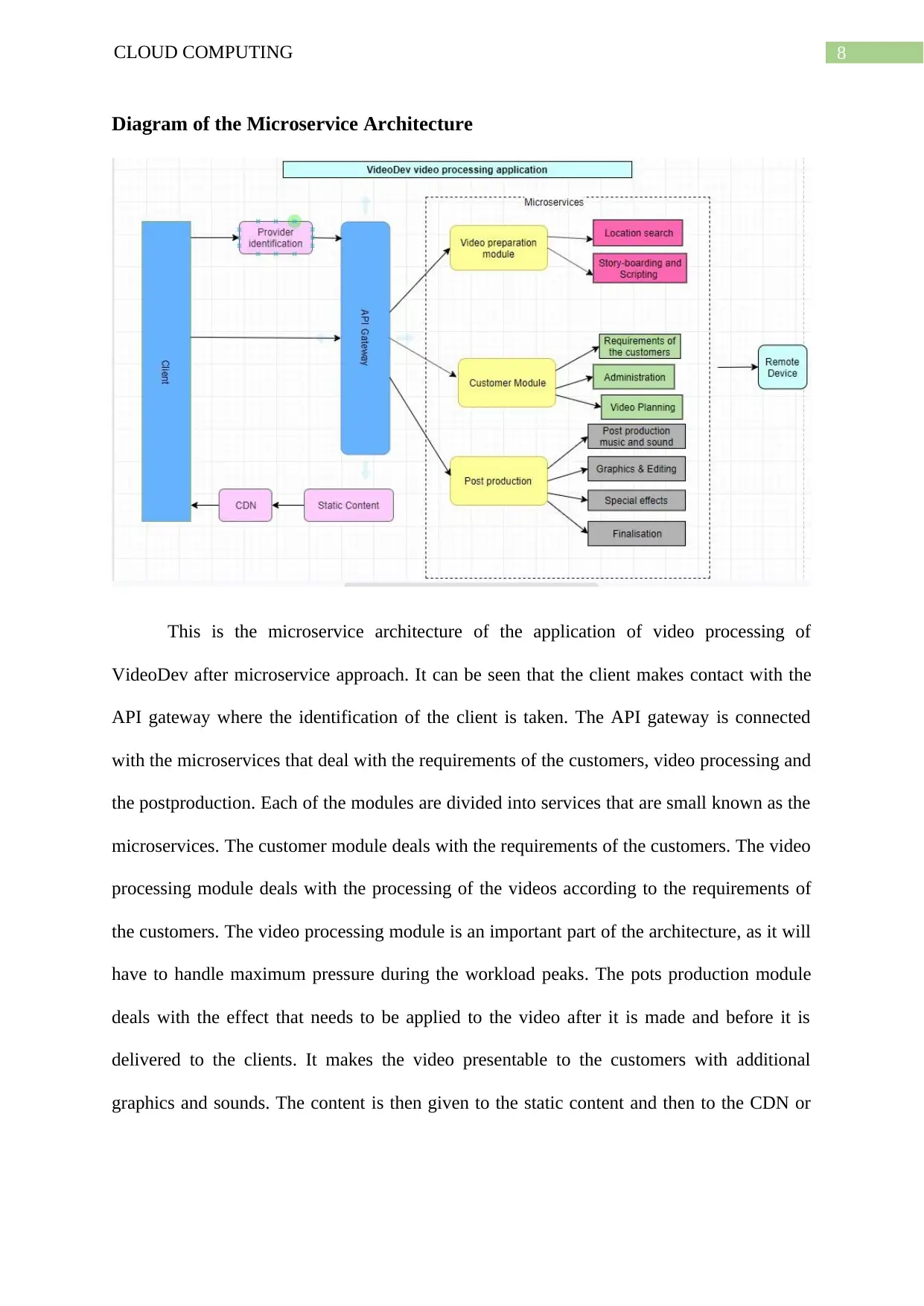
8CLOUD COMPUTING
Diagram of the Microservice Architecture
This is the microservice architecture of the application of video processing of
VideoDev after microservice approach. It can be seen that the client makes contact with the
API gateway where the identification of the client is taken. The API gateway is connected
with the microservices that deal with the requirements of the customers, video processing and
the postproduction. Each of the modules are divided into services that are small known as the
microservices. The customer module deals with the requirements of the customers. The video
processing module deals with the processing of the videos according to the requirements of
the customers. The video processing module is an important part of the architecture, as it will
have to handle maximum pressure during the workload peaks. The pots production module
deals with the effect that needs to be applied to the video after it is made and before it is
delivered to the clients. It makes the video presentable to the customers with additional
graphics and sounds. The content is then given to the static content and then to the CDN or
Diagram of the Microservice Architecture
This is the microservice architecture of the application of video processing of
VideoDev after microservice approach. It can be seen that the client makes contact with the
API gateway where the identification of the client is taken. The API gateway is connected
with the microservices that deal with the requirements of the customers, video processing and
the postproduction. Each of the modules are divided into services that are small known as the
microservices. The customer module deals with the requirements of the customers. The video
processing module deals with the processing of the videos according to the requirements of
the customers. The video processing module is an important part of the architecture, as it will
have to handle maximum pressure during the workload peaks. The pots production module
deals with the effect that needs to be applied to the video after it is made and before it is
delivered to the clients. It makes the video presentable to the customers with additional
graphics and sounds. The content is then given to the static content and then to the CDN or
⊘ This is a preview!⊘
Do you want full access?
Subscribe today to unlock all pages.

Trusted by 1+ million students worldwide
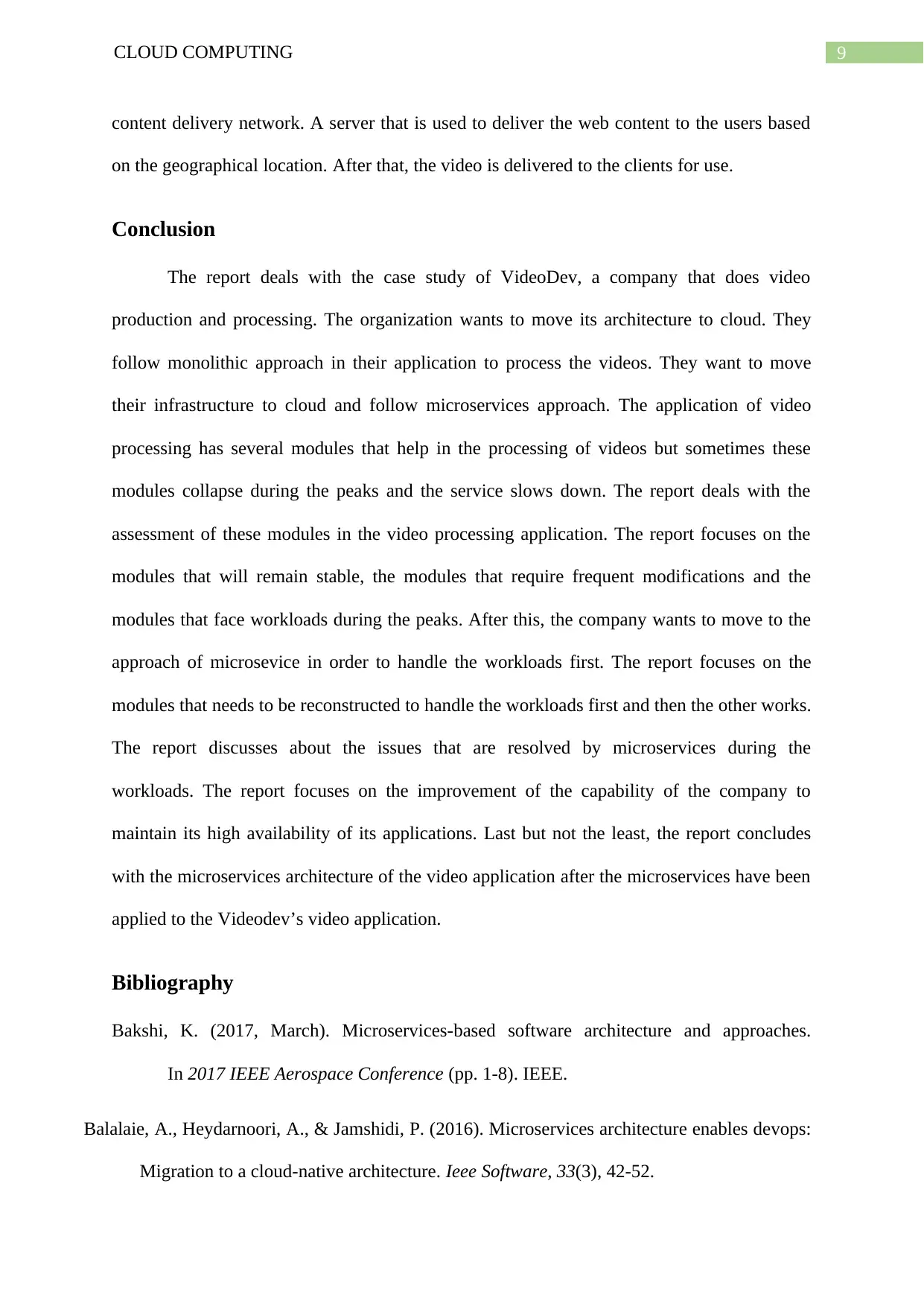
9CLOUD COMPUTING
content delivery network. A server that is used to deliver the web content to the users based
on the geographical location. After that, the video is delivered to the clients for use.
Conclusion
The report deals with the case study of VideoDev, a company that does video
production and processing. The organization wants to move its architecture to cloud. They
follow monolithic approach in their application to process the videos. They want to move
their infrastructure to cloud and follow microservices approach. The application of video
processing has several modules that help in the processing of videos but sometimes these
modules collapse during the peaks and the service slows down. The report deals with the
assessment of these modules in the video processing application. The report focuses on the
modules that will remain stable, the modules that require frequent modifications and the
modules that face workloads during the peaks. After this, the company wants to move to the
approach of microsevice in order to handle the workloads first. The report focuses on the
modules that needs to be reconstructed to handle the workloads first and then the other works.
The report discusses about the issues that are resolved by microservices during the
workloads. The report focuses on the improvement of the capability of the company to
maintain its high availability of its applications. Last but not the least, the report concludes
with the microservices architecture of the video application after the microservices have been
applied to the Videodev’s video application.
Bibliography
Bakshi, K. (2017, March). Microservices-based software architecture and approaches.
In 2017 IEEE Aerospace Conference (pp. 1-8). IEEE.
Balalaie, A., Heydarnoori, A., & Jamshidi, P. (2016). Microservices architecture enables devops:
Migration to a cloud-native architecture. Ieee Software, 33(3), 42-52.
content delivery network. A server that is used to deliver the web content to the users based
on the geographical location. After that, the video is delivered to the clients for use.
Conclusion
The report deals with the case study of VideoDev, a company that does video
production and processing. The organization wants to move its architecture to cloud. They
follow monolithic approach in their application to process the videos. They want to move
their infrastructure to cloud and follow microservices approach. The application of video
processing has several modules that help in the processing of videos but sometimes these
modules collapse during the peaks and the service slows down. The report deals with the
assessment of these modules in the video processing application. The report focuses on the
modules that will remain stable, the modules that require frequent modifications and the
modules that face workloads during the peaks. After this, the company wants to move to the
approach of microsevice in order to handle the workloads first. The report focuses on the
modules that needs to be reconstructed to handle the workloads first and then the other works.
The report discusses about the issues that are resolved by microservices during the
workloads. The report focuses on the improvement of the capability of the company to
maintain its high availability of its applications. Last but not the least, the report concludes
with the microservices architecture of the video application after the microservices have been
applied to the Videodev’s video application.
Bibliography
Bakshi, K. (2017, March). Microservices-based software architecture and approaches.
In 2017 IEEE Aerospace Conference (pp. 1-8). IEEE.
Balalaie, A., Heydarnoori, A., & Jamshidi, P. (2016). Microservices architecture enables devops:
Migration to a cloud-native architecture. Ieee Software, 33(3), 42-52.
Paraphrase This Document
Need a fresh take? Get an instant paraphrase of this document with our AI Paraphraser
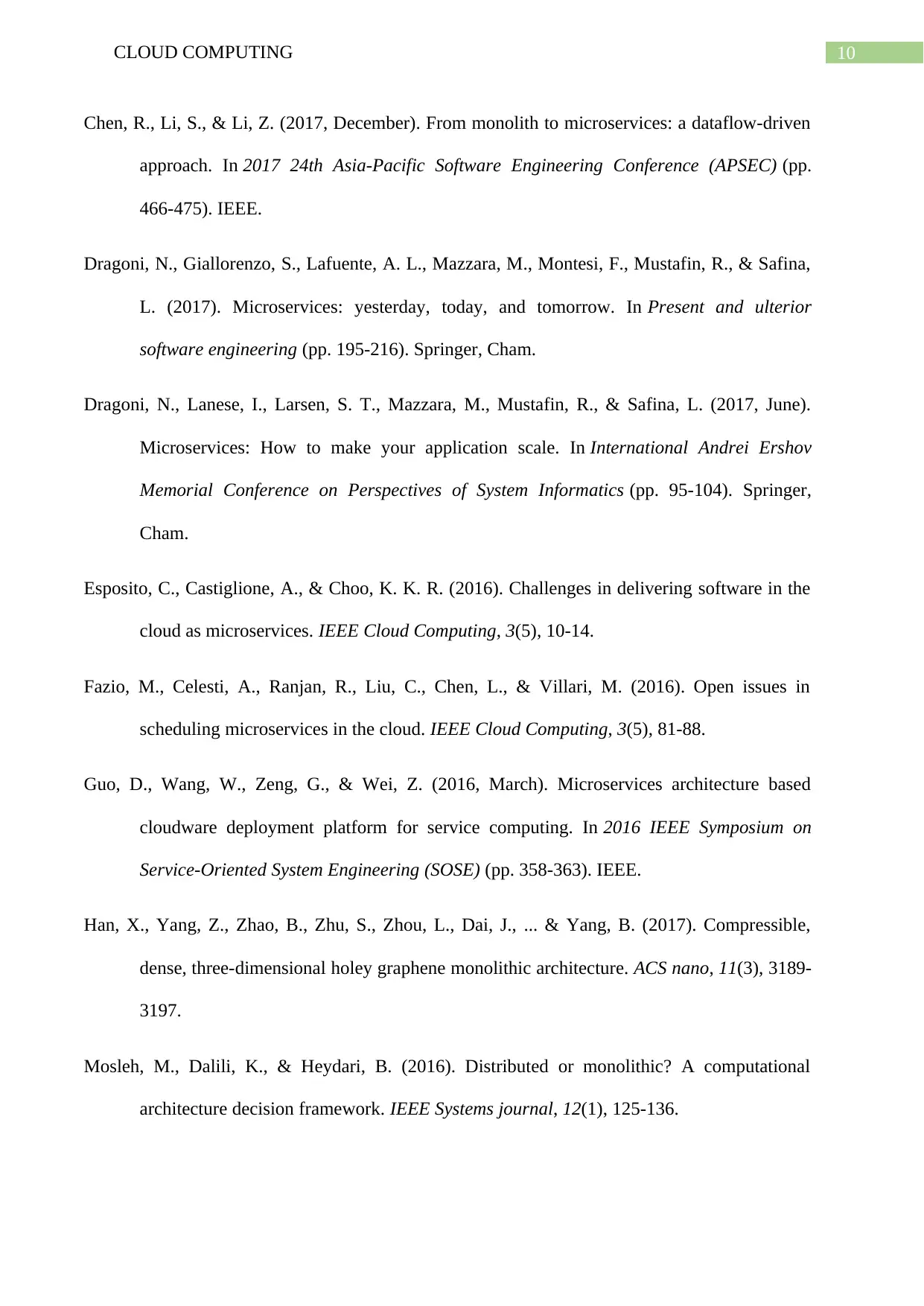
10CLOUD COMPUTING
Chen, R., Li, S., & Li, Z. (2017, December). From monolith to microservices: a dataflow-driven
approach. In 2017 24th Asia-Pacific Software Engineering Conference (APSEC) (pp.
466-475). IEEE.
Dragoni, N., Giallorenzo, S., Lafuente, A. L., Mazzara, M., Montesi, F., Mustafin, R., & Safina,
L. (2017). Microservices: yesterday, today, and tomorrow. In Present and ulterior
software engineering (pp. 195-216). Springer, Cham.
Dragoni, N., Lanese, I., Larsen, S. T., Mazzara, M., Mustafin, R., & Safina, L. (2017, June).
Microservices: How to make your application scale. In International Andrei Ershov
Memorial Conference on Perspectives of System Informatics (pp. 95-104). Springer,
Cham.
Esposito, C., Castiglione, A., & Choo, K. K. R. (2016). Challenges in delivering software in the
cloud as microservices. IEEE Cloud Computing, 3(5), 10-14.
Fazio, M., Celesti, A., Ranjan, R., Liu, C., Chen, L., & Villari, M. (2016). Open issues in
scheduling microservices in the cloud. IEEE Cloud Computing, 3(5), 81-88.
Guo, D., Wang, W., Zeng, G., & Wei, Z. (2016, March). Microservices architecture based
cloudware deployment platform for service computing. In 2016 IEEE Symposium on
Service-Oriented System Engineering (SOSE) (pp. 358-363). IEEE.
Han, X., Yang, Z., Zhao, B., Zhu, S., Zhou, L., Dai, J., ... & Yang, B. (2017). Compressible,
dense, three-dimensional holey graphene monolithic architecture. ACS nano, 11(3), 3189-
3197.
Mosleh, M., Dalili, K., & Heydari, B. (2016). Distributed or monolithic? A computational
architecture decision framework. IEEE Systems journal, 12(1), 125-136.
Chen, R., Li, S., & Li, Z. (2017, December). From monolith to microservices: a dataflow-driven
approach. In 2017 24th Asia-Pacific Software Engineering Conference (APSEC) (pp.
466-475). IEEE.
Dragoni, N., Giallorenzo, S., Lafuente, A. L., Mazzara, M., Montesi, F., Mustafin, R., & Safina,
L. (2017). Microservices: yesterday, today, and tomorrow. In Present and ulterior
software engineering (pp. 195-216). Springer, Cham.
Dragoni, N., Lanese, I., Larsen, S. T., Mazzara, M., Mustafin, R., & Safina, L. (2017, June).
Microservices: How to make your application scale. In International Andrei Ershov
Memorial Conference on Perspectives of System Informatics (pp. 95-104). Springer,
Cham.
Esposito, C., Castiglione, A., & Choo, K. K. R. (2016). Challenges in delivering software in the
cloud as microservices. IEEE Cloud Computing, 3(5), 10-14.
Fazio, M., Celesti, A., Ranjan, R., Liu, C., Chen, L., & Villari, M. (2016). Open issues in
scheduling microservices in the cloud. IEEE Cloud Computing, 3(5), 81-88.
Guo, D., Wang, W., Zeng, G., & Wei, Z. (2016, March). Microservices architecture based
cloudware deployment platform for service computing. In 2016 IEEE Symposium on
Service-Oriented System Engineering (SOSE) (pp. 358-363). IEEE.
Han, X., Yang, Z., Zhao, B., Zhu, S., Zhou, L., Dai, J., ... & Yang, B. (2017). Compressible,
dense, three-dimensional holey graphene monolithic architecture. ACS nano, 11(3), 3189-
3197.
Mosleh, M., Dalili, K., & Heydari, B. (2016). Distributed or monolithic? A computational
architecture decision framework. IEEE Systems journal, 12(1), 125-136.
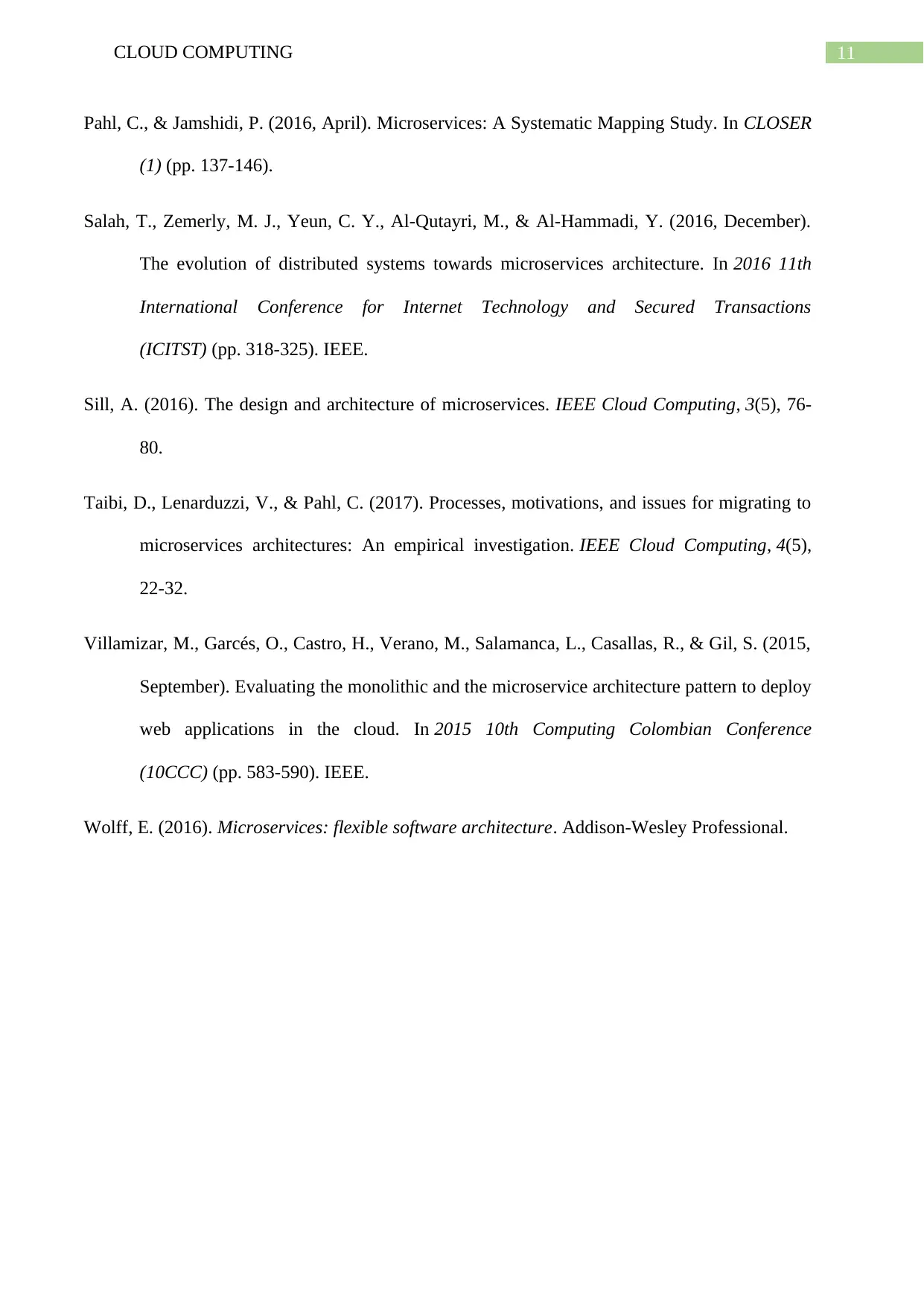
11CLOUD COMPUTING
Pahl, C., & Jamshidi, P. (2016, April). Microservices: A Systematic Mapping Study. In CLOSER
(1) (pp. 137-146).
Salah, T., Zemerly, M. J., Yeun, C. Y., Al-Qutayri, M., & Al-Hammadi, Y. (2016, December).
The evolution of distributed systems towards microservices architecture. In 2016 11th
International Conference for Internet Technology and Secured Transactions
(ICITST) (pp. 318-325). IEEE.
Sill, A. (2016). The design and architecture of microservices. IEEE Cloud Computing, 3(5), 76-
80.
Taibi, D., Lenarduzzi, V., & Pahl, C. (2017). Processes, motivations, and issues for migrating to
microservices architectures: An empirical investigation. IEEE Cloud Computing, 4(5),
22-32.
Villamizar, M., Garcés, O., Castro, H., Verano, M., Salamanca, L., Casallas, R., & Gil, S. (2015,
September). Evaluating the monolithic and the microservice architecture pattern to deploy
web applications in the cloud. In 2015 10th Computing Colombian Conference
(10CCC) (pp. 583-590). IEEE.
Wolff, E. (2016). Microservices: flexible software architecture. Addison-Wesley Professional.
Pahl, C., & Jamshidi, P. (2016, April). Microservices: A Systematic Mapping Study. In CLOSER
(1) (pp. 137-146).
Salah, T., Zemerly, M. J., Yeun, C. Y., Al-Qutayri, M., & Al-Hammadi, Y. (2016, December).
The evolution of distributed systems towards microservices architecture. In 2016 11th
International Conference for Internet Technology and Secured Transactions
(ICITST) (pp. 318-325). IEEE.
Sill, A. (2016). The design and architecture of microservices. IEEE Cloud Computing, 3(5), 76-
80.
Taibi, D., Lenarduzzi, V., & Pahl, C. (2017). Processes, motivations, and issues for migrating to
microservices architectures: An empirical investigation. IEEE Cloud Computing, 4(5),
22-32.
Villamizar, M., Garcés, O., Castro, H., Verano, M., Salamanca, L., Casallas, R., & Gil, S. (2015,
September). Evaluating the monolithic and the microservice architecture pattern to deploy
web applications in the cloud. In 2015 10th Computing Colombian Conference
(10CCC) (pp. 583-590). IEEE.
Wolff, E. (2016). Microservices: flexible software architecture. Addison-Wesley Professional.
⊘ This is a preview!⊘
Do you want full access?
Subscribe today to unlock all pages.

Trusted by 1+ million students worldwide
1 out of 12
Related Documents
Your All-in-One AI-Powered Toolkit for Academic Success.
+13062052269
info@desklib.com
Available 24*7 on WhatsApp / Email
![[object Object]](/_next/static/media/star-bottom.7253800d.svg)
Unlock your academic potential
Copyright © 2020–2025 A2Z Services. All Rights Reserved. Developed and managed by ZUCOL.



